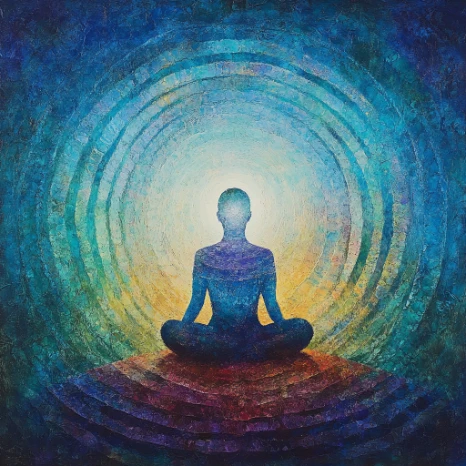Introduction: Where Did the Time Go?
You’re in the middle of a yoga class. The room is quiet, your breath is steady, and your mind starts to settle. By the time you reach Savasana, something feels different, not just in your body, but in your sense of time. The class flew by, but also felt spacious. Calm. Slower.
So, what’s happening here?
Yoga may actually change how we experience time. This isn’t just a feeling. There’s growing research showing that how we sense time is closely tied to our nervous system, breath, and emotional state.
In this article, we’ll explore:
- How stress can distort your sense of time
- What science says about yoga, breathing, and brain activity
- How meditation helps you enter a “timeless” mental state
- Simple practices to feel more grounded, spacious, and present
Let’s look at how your body and mind measure time, and how yoga can gently reset that inner clock.

How the Nervous System Shapes Time Perception
Time is more than numbers on a clock. It’s something we feel, and that feeling changes based on the state of your nervous system.
When you’re stressed or anxious, time often feels fast, fragmented, and overwhelming. That’s because stress activates your sympathetic nervous system, triggering fight-or-flight responses like racing heart rate, shallow breath, and mental tension.
But there’s more to the story.
The Interoceptive Salience Model
A 2017 study published in Psychophysiology found that after experiencing social stress, people perceived time differently, especially when viewing emotional content. They reported that both negative and positive images felt like they lasted longer than they actually did. Researchers concluded that stress distorts time perception through changes in bodily awareness and nervous system activation.
This supports the interoceptive salience model, which suggests that how we sense internal body signals, like breath, heartbeat, and muscle tension, affects how we feel time.
📚 Read the full study here (PMC5529171)
How Yoga Slows the Clock
Yoga helps reverse this stress-induced distortion.
When you practice slow, rhythmic breathing and mindful movement, you activate your parasympathetic nervous system, the part responsible for rest, digestion, and recovery. This reduces stress hormones, slows heart rate, and brings you into the present moment.
The result? Time feels more spacious. Your mind stops racing. You move from reacting to experiencing.
Try these yoga practices for stress relief to help your nervous system settle and feel more present.
The Role of Interoception in Feeling Time
Let’s talk about interoception. It’s your ability to feel what’s happening inside your body, like your heartbeat, breath, hunger, or internal tension. It’s how your brain reads your body’s signals in real-time.
The stronger your interoception, the more you feel present, and the more accurate your sense of time becomes.
When your internal signals are clear, slow breath, steady pulse, soft muscles, your brain gets the message that you’re safe. And when you feel safe, time slows down.
A 2020 systematic review in Frontiers in Psychology found that high interoception (along with high vagal tone) was strongly associated with emotional regulation, presence, and flexible thinking. The more tuned-in people were to their body’s signals, the better they handled emotions, and the calmer and connected they felt.

How Yoga Builds Interoception
Yoga supports interoception through:
- Slow, conscious breathing
- Body awareness in each pose
- Stillness that invites inward attention
By staying with your breath and feeling your body move through space, you tune in to your internal rhythms. That connection helps slow your perception of time and deepens your sense of being here, now.
How Yoga Changes Your Relationship to Time
Here’s how yoga creates a slower, more grounded experience of time through breath, movement, and stillness.
1. Slow Breath = Slow Time
When you slow your breathing, you change your brain.
Studies show that long, steady breaths influence the autonomic nervous system and increase vagal tone, which helps your body feel calm and safe. And when your body feels safe, your brain stops rushing.
This changes how you perceive time, not in theory, but physiologically.
Try gentle breathing techniques like Nadi Shodhana to regulate your inner rhythm and slow your experience of time.
2. Mindful Movement = Present Moment Awareness
Yoga is different from fast workouts. In yoga, you move slowly and match breath with each motion.
This helps your attention drop into your body, reducing mind-wandering, future worry, and mental replays of the past. Each pose becomes its own moment. You’re not rushing to finish — you’re arriving in each breath.
This mindful awareness brings your mind and body into alignment with the now, which makes time feel more expansive and clear.
3. Stillness = Timelessness
In deep stillness — like Savasana or Legs-Up-the-Wall — time often disappears.
This isn’t just relaxation. It’s the result of deep parasympathetic activation, where your nervous system drops out of doing and into being.
And when you add meditation to this stillness, it creates even more of that timeless experience. Science shows this links to a drop in Default Mode Network activity — the part of the brain that’s responsible for overthinking and mental noise.
Explore deep states of meditation where time fades away through accessible techniques anyone can try.

What Slower Time Means for Your Mind and Body
When yoga slows your experience of time, it’s not just a mental shift, it has real benefits for your brain, emotions, and health.
Better Attention and Clarity
When you’re not rushing through thoughts or tasks, you can actually focus better. Studies on Default Mode Network (DMN) activity show that when meditation quiets this part of the brain, people experience less mind-wandering and better cognitive control.
A 2015 fMRI study from Yale found that experienced meditators had reduced activity in the DMN during meditation, even compared to another demanding mental task. This means that yoga and meditation may help turn down the mental noise, giving your mind more clarity and presence.
Calmer Emotions and Stronger Regulation
That sense of time slowing also supports emotional regulation. According to a 2020 systematic review, people with better interoception and higher vagal tone, both strengthened by yoga, were more emotionally flexible and better able to cope with stress.
You’re not just feeling more spacious. You’re becoming more resilient in the way you respond to life.
More Energy, Less Burnout
When time feels rushed, you feel drained. But when time feels spacious, your body and brain are in regulation mode, not survival mode.
Practicing yoga helps your nervous system recover, reducing fatigue and improving how energy flows through your day.
If you ever feel exhausted after a session, here’s why you may feel totally wiped out after class — and how to support recovery.

Simple Yoga Practices to Shift Time Perception
Here are easy ways to bring this into your routine, even if you only have 5–10 minutes:
- Nadi Shodhana (Alternate Nostril Breathing): Slows the mind and balances the nervous system
- 10-Minute Meditation or Savasana: Allows the Default Mode Network to quiet down
- Legs-Up-the-Wall Pose: Deep rest and vagus nerve activation
- Extended Exhale Practice: Inhale for 4, exhale for 8 to signal calm
- Body Scan in a Forward Fold: Feel time slowing as you tune inward
Even small practices can retrain your brain and body to experience time with more presence and ease.
Conclusion: Yoga Changes Your Relationship with Time
Yoga doesn’t actually slow down the ticking of the clock, it slows you down. And that changes everything.
When your breath deepens, your mind quiets, and your body enters a calm state, your perception of time shifts. Moments stretch out. Space opens between thoughts. You’re not rushing, you’re simply present.
Science backs this up:
- Stress speeds time up, but yoga helps reverse that effect【Van Hedger et al., 2017】
- Meditation reduces mental noise, helping you feel more spacious and grounded【Garrison et al., 2015】
- Interoception and vagal tone — both trained through yoga — are linked to better emotional regulation and presence【Pinna & Edwards, 2020】
So the next time you feel like there’s “not enough time,” pause. Breathe. Move slowly. Let yoga bring you back to now.
Try one small practice today, even 5 minutes of stillness or breath. Notice how your body feels… and how time responds.







